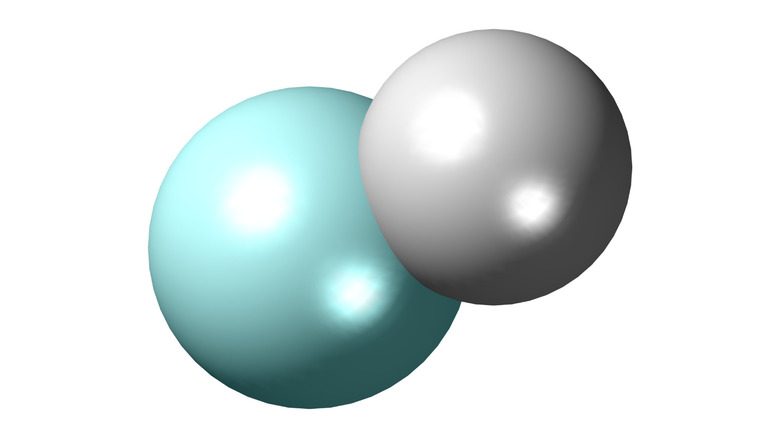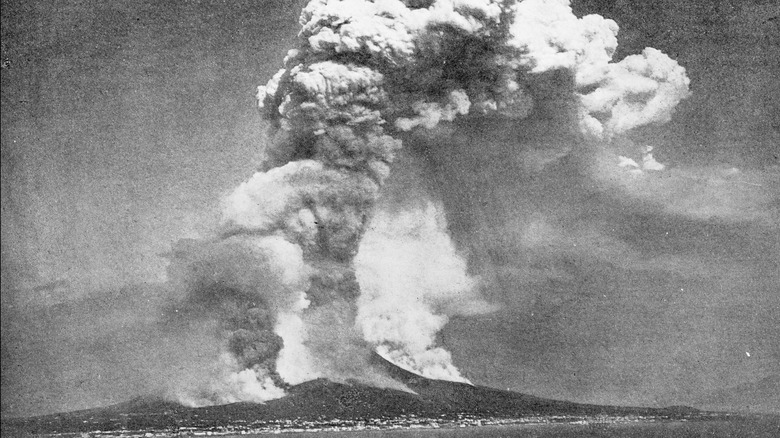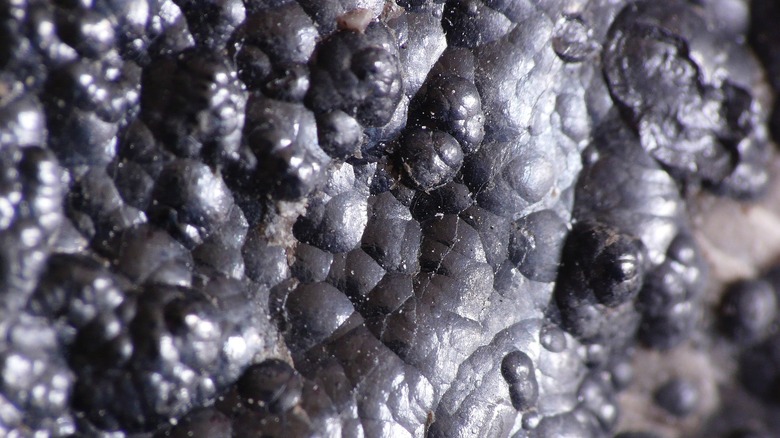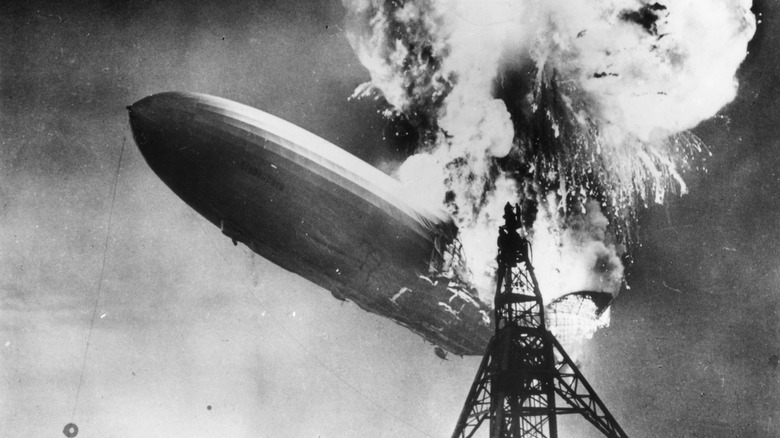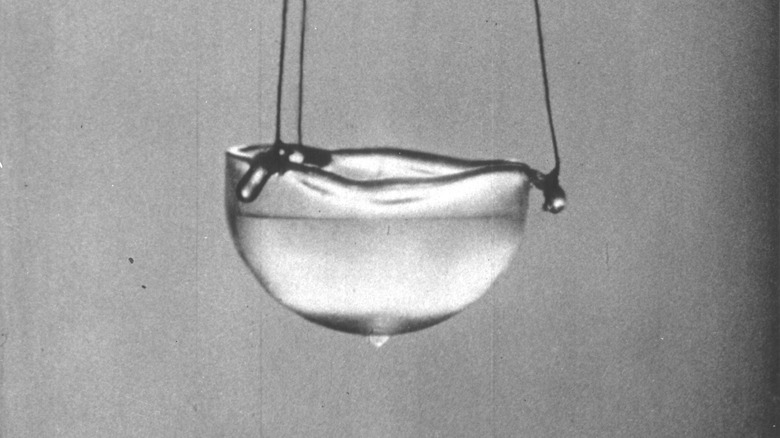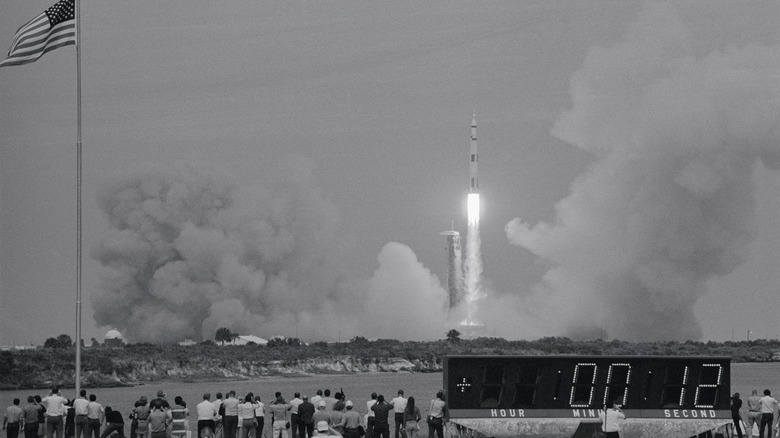The Untold History Of Helium
Everyone knows helium from party balloons and squeaky voices. But there's a lot more to helium that most people may not realize. For one thing, it's surprisingly rare. There are only a handful of significant sources of helium in the entire world, with the largest being in Algeria, Qatar, Russia, and the U.S. In Earth's atmosphere, it's found at just 5.2 parts per million, but in the planet's crust, it's only 5.5 parts per billion. This means that the gas in your birthday balloon is almost as rare as gold.
In fact, while most of us just see helium as being a frivolous thing for celebrations and parties, it's in such short supply that we're all in danger of running out of it. Per Interesting Engineering, there's an ongoing worldwide shortage of helium, and without it, a lot of modern technology could suffer — among other things, it's used to cool the magnets in hospital MRI scanners and to prepare silicon wafers for electronics. But the history of helium began long before it started to be used by humanity. While it may be vanishingly rare here on Earth, helium is the second most common chemical element in the entire universe, created in vast quantities by the Big Bang. A lot of the helium out there is as old as the universe itself.
Helium created the first molecules in the universe
While the history of humanity knowing about helium is relatively recent, the history of the element itself is quite literally a tale as old as time. And the beginning of that tale may be quite surprising. In school, one of the first things everyone learns about helium is that it's a noble gas. It doesn't react, and it doesn't form molecules. The reality, however, is slightly more complicated. When the universe was first formed, it contained just three elements — hydrogen, helium, and a faint whisper of lithium. In the first moments after the Big Bang, the hydrogen and helium reacted together to form the very first molecules, helium hydride. With the formula HeH+, this was the first chemistry in the universe.
Outlandish though it may sound, helium hydride still forms naturally in space today, though only if it has the right conditions to do so. Per NASA, astronomers have observed it in a planetary nebula, the death shroud of a star that was once much like our own sun. Scientists have also created it in the laboratory, but it's historically been difficult to study. While helium can indeed form molecules, it still doesn't like to do so. Helium hydride is very reactive, destroyed the moment it collides with anything at all. In the first moments of the universe, it was likely being created and destroyed constantly as the glow from the Big Bang began to fade.
Earth cannot hold onto helium
The reason helium is so rare on Earth is that Earth isn't very good at holding onto it. Our planet's gravity simply isn't strong enough to retain it, so any helium in Earth's atmosphere steadily escapes into space. Essentially, all helium that finds its way into the atmosphere is irretrievably lost. When you burst a helium balloon, that gas is gone and can never be recovered again. As a result, Earth is constantly running out of helium, and it always has been.
Earth formed some 4.5 billion years ago, from the same nebula of cosmic gas and dust that formed the sun. At the time, some helium from space was trapped inside the planet as it condensed and, per Science Daily, it's been slowly leaking out ever since. Like a gargantuan balloon, helium trapped in Earth's core steadily seeps out, and this helium confirms the way our planet formed. It contains different isotopes; atoms containing a different number of neutrons. Most helium is helium-4, containing two protons and two neutrons, but the other most common type is helium-three, with only one neutron. The nebula which formed the sun and Earth was rich in helium-3, and that same helium-3 is still finding its way out of the planet's core. The fact that Earth's heart is so full of this helium-3 gives scientists some compelling proof for how we believe the world first formed.
It was first seen during a solar eclipse
Astronomers in history have often used solar eclipses as rare opportunities to study the sun. With most of its light blocked by the moon, it becomes much easier to observe solar flares to learn what they're made of. Seen during an eclipse, solar flares can be seen with a ruby red color, from hydrogen, but there are a few other colors hidden in them too — a solar flare has a spectrum with a characteristic fingerprint of lines, each one emitted by a specific element. In 1868, a group of astronomers from France and the U.K. were doing exactly this, when they noticed a line that didn't correspond to any known element. An account of their expedition was published in the Proceedings of the Royal Society, but the element they'd seen remained a mystery.
The mysterious line was soon seen again by English astronomer Norman Lockyer, who would go on to found the scientific journal Nature. He developed a way to look at solar prominences without needing to wait for an eclipse and realized that the unknown line was a previously undiscovered element. It was Lockyer who proposed the name helium, from the Greek word helios, for both the sun itself and the sun god from Greek mythology.
It was first found on Earth in a volcano
Astronomers were the first to see helium and, per APS News, at first some believed it could only exist in the sun. It wasn't until 1882 that Italian volcanologist Luigi Palmieri saw the same helium line while studying an eruption from Mount Vesuvius. This was the first hint that the element could also be found here on Earth, as well as showing that helium can come from deep below the ground.
Since then, scientists have found that the heat from volcanoes can release trapped helium from rocks deep below the ground. This helium can be released along with other gasses during a volcanic eruption, as well as during the seismic activity leading up to it. As Wired explains, the isotope ratio of volcanic helium can give volcanologists information on where under the Earth the lava came from. When volcanoes release greater quantities of helium, it tends to contain more helium-3, meaning it came from deeper inside the Earth.
It was first isolated from uranium minerals
Pitchblende is a lustrous and oily-looking black mineral full of uranium. Also known as uranite, it's dense, radioactive, and one of the richest sources of uranium that can be mined. It's also a natural source of helium. While helium is considered the only completely non-renewable resource on Earth, it can actually be produced by radioactive decay, as heavy elements fragment into lighter ones. One type of radioactivity is alpha decay, where heavy atoms like uranium spit out energetic alpha particles — and these alpha particles are actually the nuclei of helium atoms, specifically helium-4.
This is what allowed the Scottish chemist William Ramsey to be the first to isolate helium in a laboratory, obtaining the first pure sample of the gas. In 1895, he published his findings in the Proceedings of the Royal Society of London, explaining how he'd been working with a type of uranite called cleveite. Dissolving the mineral in acid, it released a surprising amount of gas, which he identified as helium. A few years later, New Zealand physicist Ernest Rutherford would publish a study in the Philosophical Magazine, confirming that the alpha particles released from radioactive decay are indeed the nuclei of helium atoms. Rutherford's study was on radium, but alpha decay follows the same mechanism for any atom, meaning that many decaying radioactive elements in Earth's crust are actively producing helium-4.
[Featured image by Weirdmeister via Wikimedia Commons | Cropped and scaled | CC BY-SA 4.0]
The U.S. once used it to build airships
Airships are mostly forgotten now, but the U.S. once had grand plans for them following the chance discovery that a lot of helium lies underneath North America. In 1903, engineers running an oil drilling operation in Kansas struck a large geyser of gas. This in itself isn't unusual; oil wells often contain natural gas. In this case, though, they found that the gas was completely unburnable because it was full of helium. Several other helium fields were soon discovered in other U.S. states too, including Texas, Oklahoma, and New Mexico. With such abundant helium being mined, the U.S. began to stockpile it after World War I, with the intent to build a fleet of airships.
Several airships were constructed in America in the early 20th century, like the USS Shenandoah. Based on the design of a high-altitude German bomber from World War I, this was the first rigid airship constructed by the United States, and the world's first rigid airship powered by helium. Just over two decades later, in 1925, this led the U.S. government to form the National Helium Reserve. Based in Amarillo, Texas, they aimed to keep a large supply of the gas to supply airships, both for the military and for commercial use. While often overlooked by history, the American Chemical Society notes that blimps filled with helium were essential to U.S. military operations during World War II, when they escorted ships carrying both troops and supplies.
A ban on helium exports led to the Hindenburg disaster
With the U.S. intending to construct a whole fleet of airships and running some of the most plentiful helium wells in the world, the government was eager to maintain a monopoly on the gas. This led U.S. Congress to pass the Helium Act of 1925. As well as being the act that formed the National Helium Reserve, this also prohibited the export of helium to other countries. The knock-on effect was that it forced other countries to use hydrogen in their airships instead, and the result would be one of the most famous and spectacular disasters in 20th-century history.
In 1937, the LZ 129 Hindenburg was the world's grandest airship. A rigid airship equipped to carry passengers, it was the longest and largest aircraft in the world at the time. While in New Jersey, it was struck with a tragedy that would shock the entire world as the entire vessel went up in flames while airborne. As Smithsonian Magazine mentions, the age of the airship was already waning, and the Hindenburg incident brought it to a dramatic close. While there are still disagreements and mysteries surrounding what exactly caused the fire to start, it was undeniably catastrophic, igniting the hydrogen inside the airship and sending the whole thing crashing to the ground. Shortly after the blaze, people stopped building airships altogether.
The U.S. navy first used it to keep divers sober
The history of diving goes back centuries, and early diving suits were first created in 1771. As diving technology improved, people were able to venture deeper below the waves, but this came with an unexpected side effect. According to a paper in the Journal of Emergency Medicine, in 1826 divers first reported feelings of intoxication while underwater. The euphoric effect they were feeling was identified in 1935, by the American physician Albert Behnke, as being because of nitrogen. Sometimes given poetic colloquial names like depth intoxication or the rapture of the deep, the medical term for this is nitrogen narcosis. Simply put, breathing nitrogen under pressure causes a narcotic effect, causing changes in consciousness and impaired muscle control — potentially a severe hazard in a dangerous situation like a deep dive.
In the 1930s, in an attempt to find a way around this, the U.S. Navy Experimental Diving Unit started working on developing a breathing mixture for divers which would be safe to use. With the U.S. having a plentiful supply of helium at their disposal, experts settled on a mixture that used helium instead of nitrogen. Helium is harmless and has no intoxicating effects, and the helium breathing mixtures used by navy divers were so successful that helium mixtures are still used by scuba divers today. Modern divers often use a mixture called trimix, with a combination of oxygen, nitrogen, and helium, tailored to the depth they're diving to.
It showed scientists the way to a new state of matter
Helium has some bizarre physical properties. It doesn't condense into a liquid until just 5 degrees above absolute zero and doesn't form a solid at all under atmospheric pressure, which doesn't seem to make physical sense. Stranger, in 1938, physicist Pyotr Leonidovich Kapitsa discovered that close to absolute zero, liquid helium has almost no viscosity. His findings, reported in Nature, were the first description of what's now known as superfluidity. Superfluids show a lot of strange properties, like moving without friction and climbing the sides of their containers. The reason is that, at these low temperatures, quantum mechanics takes over and makes its effects felt even at the macroscopic scale. Studying superfluid helium has given physicists insights that would have been impossible to obtain any other way.
This odd behavior is closely related to a Bose-Einstein condensate, one of the unusual states of matter beyond the standard three of solid, liquid, and gas. These are formed under extremely cold conditions when a liquid stops behaving like a collection of atoms and starts to behave like one single "super-atom." Superfluid helium shows some very similar properties to this, but it isn't quite the same thing though. It wouldn't be until 1995 that physicists would create a true Bose-Einstein condensate in the laboratory.
It was vital during the space race
During the Cold War, the U.S. and USSR were locked in the Space Race, both trying to prove technological superiority over the other. As both nations were constructing ever larger rockets, helium became a vital part of rocket propellant systems — not because it burns but because it doesn't. Helium, per The Conversation, was used to pressurize the liquid fuel tanks used in rockets. During a launch, the helium gas would ensure a steady supply of fuel to the rocket engines. The larger the rocket, the larger the fuel tanks, and the more helium was needed. When NASA constructed the enormous Saturn V rockets to carry astronauts to the moon, they needed a prodigious amount of helium.
Helium worked so well in rocket propellant systems that space agencies continued to use it well after the Space Race was over. When NASA launched the first space shuttle in the 1980s, it also used a helium-based system in its fuel tanks. As well as keeping the tanks pressurized, helium is also useful for purging fuel lines to clear them of any unburnt hydrogen or other rocket fuels. Similar systems are still being designed and improved upon today.
It could be mined from the moon for nuclear fusion
The two most common isotopes of helium are helium-4 and helium-3, with the latter being far less common. An interesting thing about helium-3 though, is that it's a promising potential fuel for nuclear fusion reactors. Helium-3 fusion has a good energy output and could theoretically be used to make highly efficient fusion reactors, with the huge benefit that they would produce no waste and no dangerous radioactivity. The idea to mine helium-3 from the moon goes back a few decades, first proposed in 1986 by nuclear physicist Gerald Kulcinski. NASA had found that there was helium-3 in every soil sample returned by Apollo astronauts, and calculations suggested that there may be around a million metric tons of it trapped in lunar soil.
According to the European Space Agency, the solar wind is constantly hitting the moon's surface and carrying helium-3 along with it, and mining the moon for that helium could be a good way to gather it for fusion reactors in the future — the idea has been the backdrop for sci-fi movies like "Moon" (2009), and there's a chance this may someday be elevated out of fiction and into the real world. For the time being, nuclear fusion is still very much a technology of the future, but scientists are working hard to try and build working reactors. When they do, helium-3 may well be the best fuel for the job.
There's a helium conservation movement
Helium is much more rare on Earth than most people realize, and any helium released into the atmosphere is permanently lost. Because of this fact, there's a movement to try and conserve it and prevent wasteful usage. This idea was catalyzed by America's decision to sell off its helium stockpile. A law passed in 1996 made the gas so cheap that attempting to recycle it became no longer worth the cost. The movement is endorsed by a few notable scientists including Nobel laureates like Robert Richardson, a professor of physics at Cornell University.
The biggest concern is that helium is essential to a lot of important modern uses, from the spacecraft used to launch satellites into orbit to medical imaging technology vital for hospital patients. If helium use isn't conserved, Earth's supplies of it could become depleted too rapidly, with the most alarming estimates being that it could dwindle to virtually nothing within a generation. In 2012, Nature published an article entitled, simply, "Stop squandering helium." It highlights the fact that there's now an ongoing helium shortage in the world while the demand for it keeps increasing. The authors suggest forming an international helium agency to better regulate it and treat it as a precious resource. Perhaps we should all treat helium with more care, in case we find ourselves without any left.

